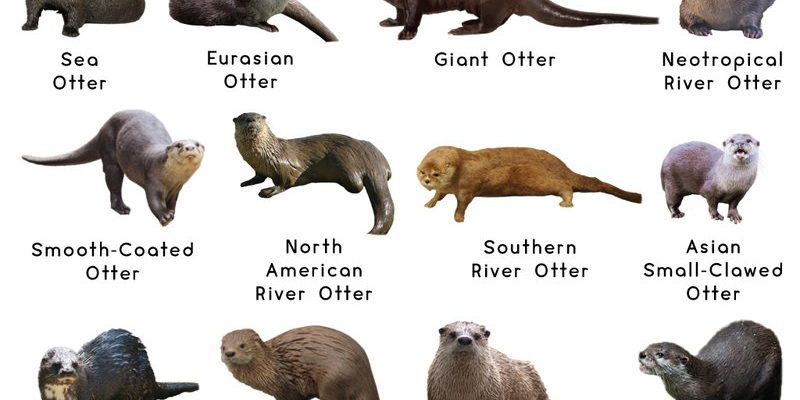![Comparing The Giant Otter Vs. [Similar Species]](https://gudri.com/wp-content/uploads/2025/06/Comparing_The_Giant_Otter_Vs___Similar_Species__image_0.jpg)
The Giant Otter, known for its impressive size and striking features, roams the rivers and lakes of South America. On the other hand, the North American River Otter is a more familiar face, found across North America, from coast to coast. While both are adorable and share a love for water, their lifestyles and habitats set them apart. Let’s dive deeper into what makes these two fascinating species unique.
Physical Characteristics
When comparing the Giant Otter and the North American River Otter, one of the first things to notice is size. The Giant Otter can grow to about 5.5 feet long and can weigh up to 75 pounds, making it the largest otter species in the world. Its sleek, muscular body and large webbed feet are perfectly designed for swimming. They have dense, luxurious fur that keeps them warm in cooler waters, with a striking pattern that features a lighter-colored throat and belly.
In contrast, the North American River Otter measures around 3 to 4 feet in length and typically weighs between 50 to 100 pounds. They have a more playful appearance, often seen sliding down mud or snow banks into the water. Their fur is also dense but is slightly shorter than that of the Giant Otter. While both animals are undeniably cute, the Giant Otter’s impressive size can be quite intimidating!
Habitat
The habitats of these two otter species tell another part of their story. The Giant Otter prefers the fresh waters of the Amazon and Orinoco River basins and is highly dependent on healthy river ecosystems. They thrive in areas where the water is clear and rich in fish, as these are their primary food source. However, they’re also known to inhabit lakes and wetlands, showing their adaptability in various environments.
On the flip side, the North American River Otter is a bit of a wanderer. Found in a variety of habitats, including rivers, lakes, and coastal areas, they adapt to both freshwater and saltwater ecosystems. Their ability to thrive in diverse environments allows them to be one of the most widespread otter species in North America, which is fantastic for their survival!
Diet and Hunting Techniques
Diet is another key area where these two otters diverge. The Giant Otter is primarily piscivorous, meaning they mainly eat fish. They are known to hunt cooperatively in family groups, often working together to herd fish into tighter pools for easier catching. They also enjoy crustaceans and small mammals, showcasing their versatility as hunters. Their keen eyesight and sensitive whiskers help them locate prey even in murky waters.
Meanwhile, the North American River Otter has a broader diet. They feast on fish as well, but they’re also known to munch on amphibians, birds, and even small mammals. Their playful nature often comes into play during hunting as they’ll chase after their food, turning their search into a high-energy game. This behavior not only helps them catch meals but also solidifies their status as playful creatures of the water.
Social Behavior
When it comes to social behavior, these otters show different tendencies. Giant Otters are highly social animals that live in family groups called rafts. These groups can include up to 20 individuals, and they communicate with each other through a series of vocalizations. Their teamwork is really impressive as they often collaborate on hunts and nurture their young together. Honestly, watching a raft of Giant Otters work as a unit is like witnessing a well-rehearsed dance in the water.
In contrast, North American River Otters can be more solitary. They live in smaller family units, typically consisting of a mother and her kits. While they may come together for mating or during the winter months, they generally prefer their own space. However, they still exhibit playful behavior and often engage in socializing when they’re not hunting or resting. Their expressive antics can be quite entertaining to observe!
Conservation Status
Now, let’s talk about conservation. The Giant Otter is classified as Endangered, primarily due to habitat destruction and hunting. Deforestation and pollution in their Amazonian habitats have led to a decline in their populations. Conservation efforts are ongoing, with various organizations working to protect these remarkable creatures and their environments. It’s vital to raise awareness and support initiatives that aim to preserve their natural habitats for future generations.
The North American River Otter, on the other hand, is classified as Least Concern, thanks to effective conservation laws and habitat protection efforts. Although they do face threats from pollution and habitat loss, their populations are currently stable in many areas. That said, it’s always a good idea to keep an eye on their habitats and support local conservation efforts to ensure they remain safe.
Both the Giant Otter and the North American River Otter are incredible species that showcase the diversity of the otter family. While they share some similarities, like their love for water and fish, their size, habitats, and social behaviors help distinguish them from each other. The next time you come across an otter—whether it’s the giant, majestic kind or the playful river-dwelling version—you’ll have a deeper appreciation for these fascinating creatures and their roles in our ecosystems.
So, whether you’re out in the wild or just enjoying a nature documentary at home, take a moment to celebrate these wonderful animals. They’re not just cute; they play an essential role in maintaining the health of our waterways and ecosystems. And that’s something worth caring about!

